Phylum echinodermata - Study guides, Class notes & Summaries
Looking for the best study guides, study notes and summaries about Phylum echinodermata? On this page you'll find 106 study documents about Phylum echinodermata.
Page 2 out of 106 results
Sort by
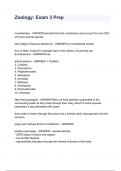
-
Zoology: Exam 3 Prep questions and answers
- Exam (elaborations) • 15 pages • 2024
-
- $7.99
- + learn more
invertebrates - ANSWER-animals that lack a backbone and account for over 95% of known animal species blue dragon (Glaucus atlanticus) - ANSWER-an invertebrate animal true or false: expect for sponges (and a few others), all animals are Eumetazoans - ANSWER-true animal phylum - ANSWER-1. Porifera 2. Cnidaria 3. Ctenophora 4. Platyhelminthes 5. Nematoda 6. Annelida 7. Mollusca 8. Arthropoda 9. Echinodermata 10. Chordata filter feed (sponges) - ANSWER-filter out food particles suspen...
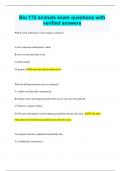
-
Bio 172 animals exam questions with verified answers
- Exam (elaborations) • 19 pages • 2024
- Available in package deal
-
- $9.99
- + learn more
Bio 172 animals exam questions with verified answers Which of the following is (are) unique to animals? A) the structural carbohydrate, chitin B) nervous and muscular tissue C) heterotrophy D) gametes B) nervous and muscular tissue What do all deuterostomes have in common? A) Adults are bilaterally symmetrical. B) Embryos have pharyngeal pouches that may or may not form gill slits. C) All have a spinal column. D) The pore (blastopore) formed during gastrulation becomes the anu...

-
Bio 117 exam 2 quiz with 100% correct solutions
- Exam (elaborations) • 49 pages • 2024
- Available in package deal
-
- $13.49
- + learn more
Bio 117 exam 2 quiz with 100% correct solutions Which of the following is NOT a characteristic of ALL animals? A. Heterotrophic B. Together, they form a monophyletic group. C. Multicellular organisms D. Cells lacking cell walls. E. All animals have true tissues and organs. - Correct Answer ️️ -All animals have true tissues and organs. Which of the following are characteristics of Phylum Cnidaria? (Select All that Apply) A. Specialized stinging cells B. True Tissues C. Comp...

-
Bio 117 exam 2 quiz with 100% correct solutions
- Exam (elaborations) • 49 pages • 2024
-
- $13.49
- + learn more
Bio 117 exam 2 quiz with 100% correct solutions Which of the following is NOT a characteristic of ALL animals? A. Heterotrophic B. Together, they form a monophyletic group. C. Multicellular organisms D. Cells lacking cell walls. E. All animals have true tissues and organs. - Correct Answer ️️ -All animals have true tissues and organs. Which of the following are characteristics of Phylum Cnidaria? (Select All that Apply) A. Specialized stinging cells B. True Tissues C. Comp...
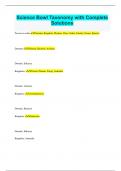
-
Science Bowl Taxonomy with Complete Solutions
- Exam (elaborations) • 4 pages • 2024
- Available in package deal
-
- $8.99
- + learn more
Science Bowl Taxonomy with Complete Solutions Taxons in order Domain, Kingdom, Phylum, Class, Order, Family, Genus, Species Domains Eukarya, Bacteria, Archaea Domain: Eukarya Kingdoms: Protista, Plantae, Fungi, Animalia Domain: Archaea Kingdom: Archaebacteria Domain: Bacteria Kingdom: Eubacteria Domain: Eukarya Kingdom: Animalia Phylum: Porifera, Cnidaria, Platyhelminthes, Nematoda, Annelida, Arthropoda, Mollusca, Echinodermata, Chordata Phylum: Species: Huma...
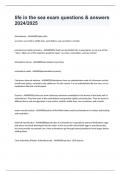
-
life in the sea exam questions & answers 2024/2025
- Exam (elaborations) • 11 pages • 2024
-
Available in package deal
-
- $8.99
- + learn more
life in the sea exam questions & answers 2024/2025 Echinoderms - ANSWERS(Spiny skin) sea stars, sea urchins, brittle stars, sand dollars, sea cucumbers, crinoids pentamerous radial symmetry - ANSWERSthe body can be divided into 5 equal parts, so any one of five "slices" taken out of the organism would be equal. "sea stars, sand dollars, and sea urchins" Echinoderm larvae - ANSWERShave bilateral symmetry echinoderm adult - ANSWERSpentaradial symmetry Calcareous internal skel...
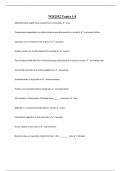
-
WIS2552 Topics 1-8
- Exam (elaborations) • 41 pages • 2024
-
Available in package deal
-
- $9.49
- + learn more
WIS2552 Topics 1-8 Multicellularity might have evolved from coloniality. ️true Temperature-dependent sex determination was discovered in a study of ️red-eared turtles Caecilians are not found in the tropics of ️Australia Smaller lizards are mostly adapted for feeding on ️insects The introduced Nile Monitor in Florida may possibly become a threat to native ️burrowing owls Terrestrial Caecilians are mostly adapted for ️burrowing Echinodermata is a phylum of ️deuterosto...
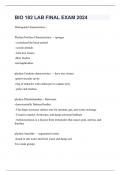
-
BIO 182 LAB FINAL EXAM 2024
- Exam (elaborations) • 11 pages • 2024
-
Available in package deal
-
- $13.99
- + learn more
Distinguish Characteristics - Phylum Porifera Characteristics - - sponges - considered the basal animal - sessile animals - lack true tissues -filter feeders -hermaphrodites phylum Cnidaria characteristics - - have true tissues -gastrovascular cavity -ring of tentacles with cnidocytes to capture prey - polys and medusa phylum Platyhelminthes - flatworms -dorsoventrally flattened bodies - Flat shape increases surface area for nutrient, gas, and waste exchange - Found in mar...

-
BIOL 198 Module 7 Exam Questions With 100% Correct Answers
- Exam (elaborations) • 18 pages • 2024
- Available in package deal
-
- $12.49
- + learn more
BIOL 198 Module 7 Exam Questions With 100% Correct Answers Identify the characteristics that distinguish animals from other types of organisms. - answerMulticellular Heterotrophic Motile Reproduce sexually Use aerobic metabolism Lack cell walls Have life cycles that include development from undifferentiated cells Have a variety of body plans Distinguish between asymmetry, radial symmetry, and bilateral symmetry. - answerAsymmetry: no particular organization Radial symmetry: Circular...
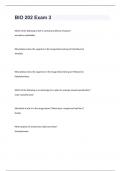
-
BIO 202 Arizona State University -BIO 202 Exam 3 fully solved
- Exam (elaborations) • 18 pages • 2024
-
Available in package deal
-
- $16.99
- + learn more
BIO 202 Exam 3Which of the following is NOT a mechanical defense of plants? secondary metabolites What phylum does the organism in the image below belong to? [Earthworm] Annelida What phylum does the organisms in the image below belong to? [Flatworm] Platyhelminthes Which of the following is an advantage for a plant to undergo asexual reproduction? reach maturity faster What kind of leaf is in the image below? [What does a simple leaf look like?] Simple Which phyl...

Did you know that on average a seller on Stuvia earns $82 per month selling study resources? Hmm, hint, hint. Discover all about earning on Stuvia


